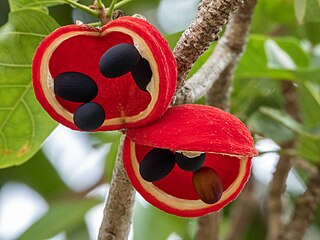Sterculiaceae was a family of flowering plant based on the genus Sterculia. Genera formerly included in Sterculiaceae are now placed in the family Malvaceae, in the subfamilies: Byttnerioideae, Dombeyoideae, Helicteroideae and Sterculioideae.

Brachychiton is a genus of 31 species of trees and large shrubs, native to Australia and New Guinea. Fossils from New South Wales and New Zealand are estimated to be 50 million years old, corresponding to the Paleogene.

Brachychiton acerifolius is a large tree of the family Malvaceae endemic to tropical and subtropical regions on the east coast of Australia. It is famous for the bright red bell-shaped flowers that often cover the whole tree when it is leafless. It is commonly known as the flame tree, Illawarra flame tree, lacebark tree, or kurrajong.

Eucalyptus eremophila, commonly known as the sand mallet or tall sand mallee, is a species of mallet that is endemic to semi-arid regions of Western Australia. It has smooth pale brown and greyish bark, narrow lance-shaped to elliptical adult leaves, flower buds arranged in groups of between seven and eleven with an elongated operculum, and cup-shaped to barrel-shaped fruit.

Sterculia quadrifida, also known as the peanut tree, monkey nut or red-fruited kurrajong is a small tree that grows in the rainforests, vine thickets, and gallery forests of New Guinea and northern Australia.

Brachychiton rupestris is a tree in the family Malvaceae, endemic to Queensland, Australia. Described by Sir Thomas Mitchell and John Lindley in 1848, it earned its name from its bulbous trunk, which can be up to 3.5 metres (11 ft) in diameter at breast height (DBH). Reaching around 10–25 metres (33–82 ft) high, the Queensland bottle tree is deciduous, losing its leaves seasonally, between September and December. The leaves are simple or divided, with one or more narrow leaf blades up to 11 centimetres (4 in) long and 2 centimetres (0.8 in) wide. Cream-coloured flowers appear from September to November, and are followed by woody, boat-shaped follicles that ripen from November to May. No subspecies are recognised.

Brachychiton populneus, commonly known as the kurrajong, is a small to medium-sized tree found naturally in Australia in a diversity of habitats from wetter coastal districts to semi-arid interiors of Victoria, New South Wales and Queensland. Carrejun and carrejan were the indigenous names of trees in the foothills of the Blue Mountains near Sydney, and the bark was used for twine and fishing lines. The extended trunk is a water storage device for survival in a warm dry climate. The bell-shaped flowers are variable in colour while the leaves vary considerably in shape. The leaves are either simple and pointed, or may be 3–9 lobed. Saplings grow from a drought and fire resistant tap-rooted tuber.

Sterculioideae is a subfamily of the family Malvaceae containing evergreen and deciduous trees and shrubs.

Brachychiton bidwillii, commonly known as the dwarf kurrajong or little kurrajong, is a small tree of the genus Brachychiton found in tropical areas of eastern Australia. It was originally classified in the family Sterculiaceae, which is now within Malvaceae.
Brachychiton paradoxus, commonly known as the red-flowered kurrajong, is a small tree of the genus Brachychiton found in northern Australia. It was originally classified in the family Sterculiaceae, which is now within Malvaceae.

Brachychiton diversifolius, commonly known as the northern kurrajong, is a small tree of the genus Brachychiton found in northern Australia. It was originally classified in the family Sterculiaceae, which is now within Malvaceae.
Franciscodendron is a monotypic genus in the subfamily Sterculioideae within the family Malvaceae. The single species, Franciscodendron laurifolium, commonly known as tulip sterculia, tulip kurrajong or cabbage crowsfoot, is a tree native to Australia.
Brachychiton compactus is a tree of the genus Brachychiton found in northeastern Australia. It is only found in the vicinity of Proserpine in Central Queensland.

Brachychiton australis, commonly known as the broad-leaved bottle tree, is a small tree of the genus Brachychiton found in eastern Australia. It was originally classified in the family Sterculiaceae, which is now within Malvaceae.

Brachychiton megaphyllus, commonly known as the red-flowering kurrajong, is a tree of the genus Brachychiton found in northern Australia.
Brachychiton spectabilis is a tree of the genus Brachychiton found in northern Australia. It was described by Gordon Guymer in 1988.
Brachychiton multicaulis is a tree of the genus Brachychiton found in northern Australia. It was described in 1988.

Acacia ramulosa, commonly known as horse mulga or bowgada wattle, is a shrub belonging to the genus Acacia and the subgenus Juliflorae endemic to arid areas of Australia.

Acacia trachycarpa, commonly known as minni ritchi, curly-bark tree, sweet-scented minni ritchi or Pilbara minni ritchi, is a shrub or tree belonging to the genus Acacia and the subgenus Juliflorae that is native to arid and semi-arid areas of Western Australia.

Brachychiton viscidulus is a plant in the Malvaceae family, native to Western Australia.
















